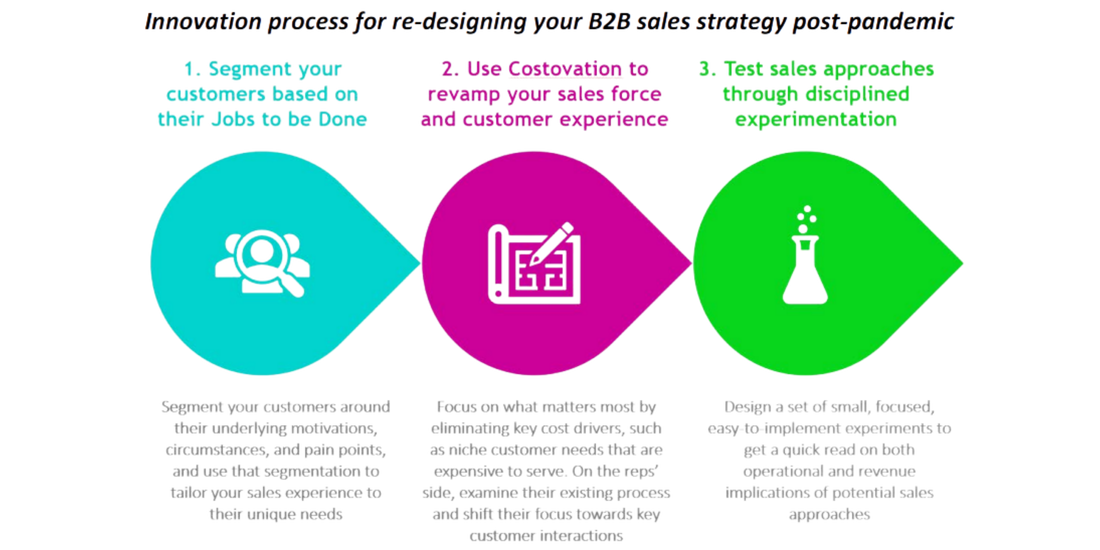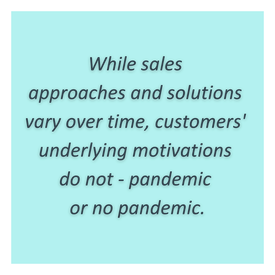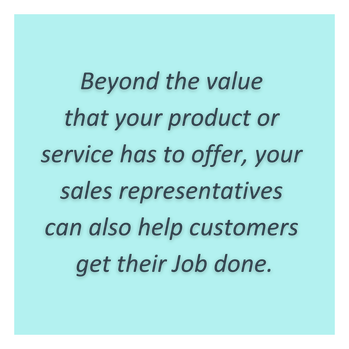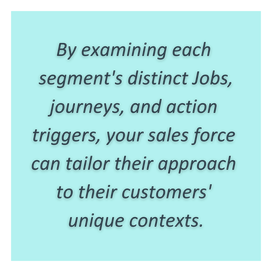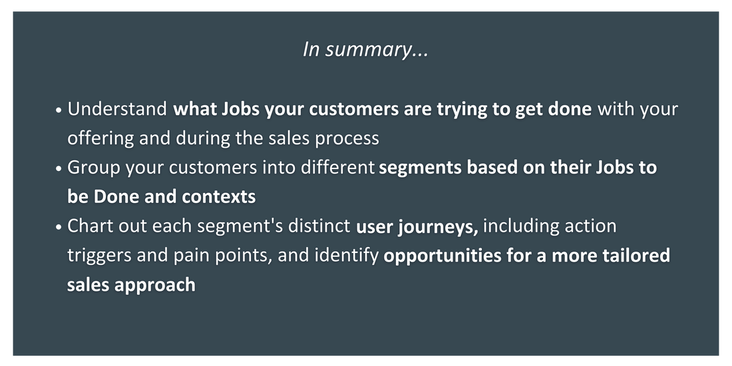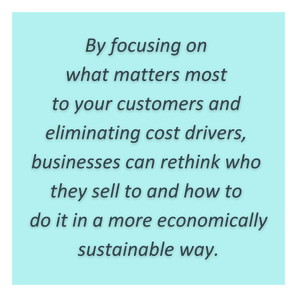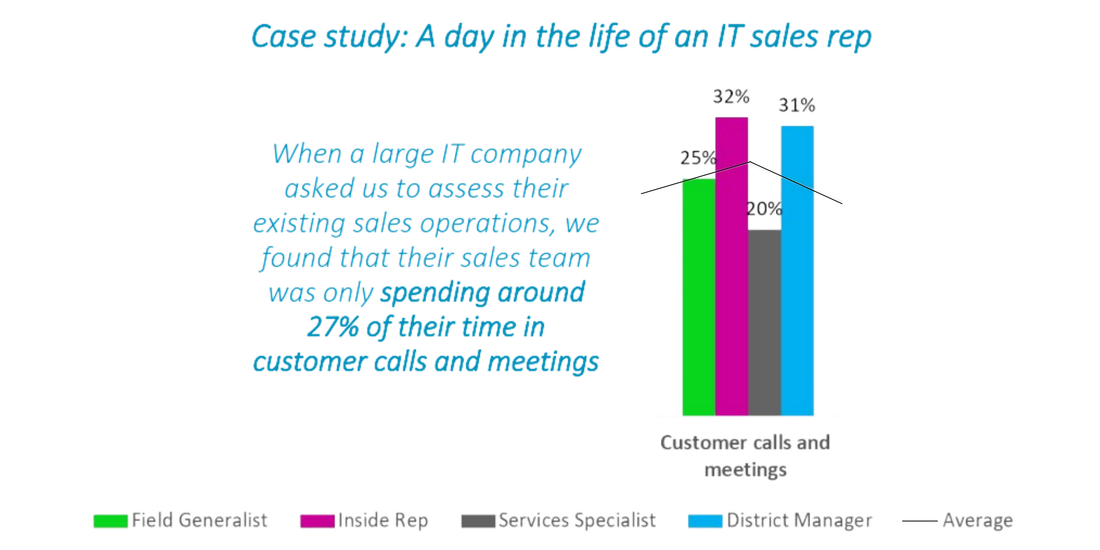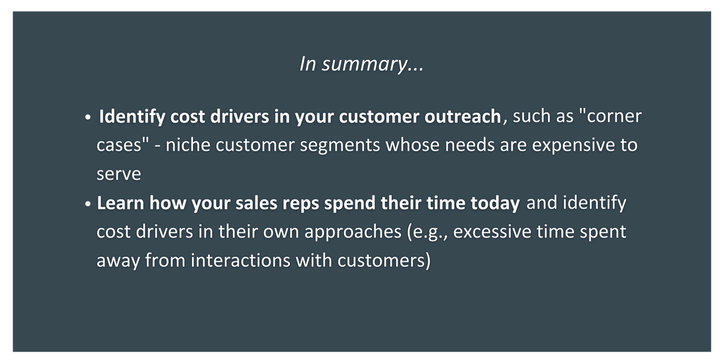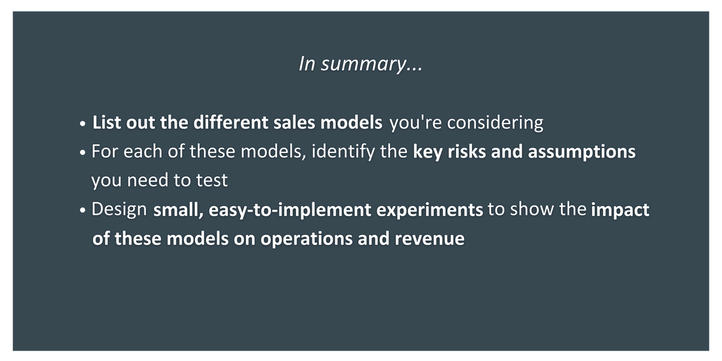|
WORKING PAPER
Three Steps to
|
|
Executive Summary
The COVID-19 pandemic has foisted lightning-fast change on B2B sales organizations already seeking to transform their cost-effectiveness. The dislocations occurring now create opportunity to reshape sales organizations and strategies for the future, including after the pandemic ends. This paper shows how sales leaders can undertake a three-step innovation process to create both incremental and radical change.
Today's Challenges In B2B Sales
For many B2B sales teams, COVID-19 is accelerating necessary progress. With in-person interactions suddenly made unsafe, businesses have had to speed up their switch to digital sales channels. They’ve also had to become more efficient as many customers reduce spend and become more price-sensitive. As sales forces revisit their strategy, many struggle to make decisions when the future seems so unclear.
While the pandemic will ultimately pass, the urgency for change will remain. Fortunately, there is a silver lining to all of the hardship wrought by the coronavirus. Both sales forces and customers have become far more receptive to change and much more accepting of virtual engagement. That does not mean the current state of affairs will persist past the pandemic – indeed, for some organizations the situation seems to change monthly – but it does suggest that we will arrive at a “new normal” that mixes both old and new forms of engagement.
How can you plan that future today? More specifically, how can sales forces drive sustainable business growth in the midst of uncertainty and financial pressures? How can they create customer engagement in ways that are both economical and compelling? We recommend using a three-step process: segmentation based on underlying Jobs to be Done, new customer and sales force experiences drawing on low-cost innovation (called Costovation), and disciplined experimentation as distinct sales strategies roll out.
While the pandemic will ultimately pass, the urgency for change will remain. Fortunately, there is a silver lining to all of the hardship wrought by the coronavirus. Both sales forces and customers have become far more receptive to change and much more accepting of virtual engagement. That does not mean the current state of affairs will persist past the pandemic – indeed, for some organizations the situation seems to change monthly – but it does suggest that we will arrive at a “new normal” that mixes both old and new forms of engagement.
How can you plan that future today? More specifically, how can sales forces drive sustainable business growth in the midst of uncertainty and financial pressures? How can they create customer engagement in ways that are both economical and compelling? We recommend using a three-step process: segmentation based on underlying Jobs to be Done, new customer and sales force experiences drawing on low-cost innovation (called Costovation), and disciplined experimentation as distinct sales strategies roll out.
Step 1: Ground Yourself In Your Customers' Jobs To Be Done
When redesigning your sales strategy, it can be difficult to know where to start. It is tempting to focus on internal performance and cost metrics, or extensive competitive benchmarking. That can be productive for incremental improvement, but it is seldom the route to true transformation. Instead, ground yourself in the basics: your customers’ needs. While sales approaches and solutions vary over time, customers’ underlying motivations do not. Pandemic or no pandemic, there are a certain set of Jobs that they try to get done – and those are the Jobs that sales forces should use as their point of reference. These provide a compass heading for transformation efforts, and they can inspire new vectors of innovation which were previously not considered.
What is the Jobs to be Done framework?
|
When a buyer purchases a product or service, they are not buying the solution itself or the features that come with it; they are trying to get a Job done. A Job to be Done is a customer’s underlying motivation behind a purchase. For instance, a medical practice might purchase a point-of-care diagnostic tool because it simplifies their workflow: that's the Job that the product helps a customer get done. But the sales representative also gets customers' Jobs done himself. A physician might engage with the rep not just to learn about the tool’s specifications, but also to understand workflow implications specific to her practice, gather evidence to present to internal committees, or reduce anxieties about changing longstanding procedures. Those Jobs can often be accomplished in many ways, and they may need prioritizing as you think through how to re-shape approaches. |
|
A Job might be more or less important for a given customer, depending on their Contexts. For example, a physician that primarily caters to elderly patients will care about ease of use when considering which device to recommend. If many of her patients live far away or have difficulty coming to her practice, she might also place more emphasis on remote patient monitoring. The importance of Jobs related to the sales process may also vary: if the physician is in a large health system, the need to marshal supporters on key committees will be more critical than at a small medical practice. |
How can Jobs help you re-design your sales strategy?
To revamp a sales strategy, it can be quite useful to segment customers based on the Jobs and Contexts relevant to what the sales force helps them get done. This is different from other segmentations that exist for other purposes, such as high- and low-volume customers, buyers with distinct purchasing behaviors, etc. Rather, it is about how the sales force delivers value to the customer based on their unique needs, which should be a fundamental underpinning of how the sales organization will adapt for the future.
|
As you segment your customers, consider how these segments have distinct action triggers, Moments of Truth, and user journeys. By plotting customer segments’ Jobs and Contexts along these variables, you can spot precise and unique opportunities for re-making what your sales force does and how it does so. Pain Points are also helpful to map out at a granular level: you may identify addressable sources of frustration that are typically overlooked, especially if they concern only a specific part of the journey. For example, a medical practice may have difficulty sifting through patient data collected by their remote monitoring system. By emphasizing how your software can help them prioritize patients for review, your sales representative would tap into the staff's desire to feel less overwhelmed with data. |
Today’s crisis is drawing executives’ attention in many different directions. But as you rethink your company’s sales strategy, think back to your customers’ foundational needs. Using Jobs to be Done, you will anchor your value proposition in buyers’ long-lasting motivations and contexts, making it more resilient in the face of uncertainty.
Step 2: Revamp Your Customer And Sales Force Experiences, Leveraging Costovation
Layoffs and budget cuts are forcing many sales teams to revisit how they allocate their resources. But these adjustments don’t have to come at the expense of customer satisfaction. This is where Costovation comes in, a type of innovation that aims to be both low-cost and high-value to your target audience. By focusing on what matters most to your customers and eliminating cost drivers – particularly the hidden costs that aren’t labeled by any budget line-item – businesses can rethink who they sell to and how to do it in a more economically sustainable way.
|
A major cost driver has to do with your audience. For many B2B businesses, a significant portion of their sales expense is driven by “corner cases” – customers with extreme needs. To get the most out of your resources, find out which customer segments to prioritize and focus on addressing their specific Jobs, Contexts, and Pain Points. For an even stronger understanding of these segments, chart out their specific user journey to identify unique areas for improvement. Also think clean-sheet about how to construct a journey based on their Jobs and Contexts; many sales organizations are surprised at how radically they can transform their operations by lifting the constraints of how things are done today, all the while remaining customercentric.
|
A second cost driver to address concerns sales approaches and channels. Several B2B sectors have been transitioning away from in-person interactions towards digital, and COVID-19 has only accelerated this trend. Yet in-person exchanges are critical in building trust among B2B customers, particularly when marketing a noncommodity product. So, while in-person engagement may become less prevalent among sales efforts, it will likely continue to be relevant well after the pandemic. Ensure that the most useful exchanges continue, while cutting away the others.
|
One important activity to undertake is to get a good handle on how your sales force spends its time today. How much of that time is spent on internal activities like determining product configuration and pricing? Remaking sales approaches can be a golden opportunity to strip out the hidden costs in how reps spend their days, re-focusing them on the high-value customer interactions that matter most.
|
Step 3: Conduct Disciplined Experimentation
Coming out of this process, you should have many ideas for how to transform your sales strategy. While there is some reality-checking you can do to vet these – such as by understanding how they register with customers and sales reps, and how much work they might take to implement – the acid test for new sales ideas is whether they work in practice.
However, it’s usually unwise to trial a host of ideas in a sales organization in a big way and all at once. That would create deep distraction, confusion, and inevitable operational hiccups. Instead, craft a set of small, focused, and easy-to-implement experiments. These will provide a quick read on both operational and revenue implications of changes being considered. When evaluating large-scale change to sales approaches, this kind of disciplined experimentation is critical to achieving strong results without taking major risks in the process.
Consider some of the principles of disciplined experimentation:
- Determine what your major risks and assumptions are
- Develop clear hypotheses
- Test a limited number of variables at any one time
- Ensure that you can measure what works and what doesn't
- Have "control groups" that operate in a business-as-usual way, so you can assess the impact of what you've changed
Speed matters. This is a unique time when people are particularly open to change. That said, sales forces typically don’t thrive under extended uncertainty. Have a timeframe to experiment, learn rapidly, and then set your course.
Conclusion
There will likely be few other occasions in our lifetimes when so much dislocation happens so fast. This is the time for sales leaders to grasp the upside of change, mapping out how both customers and sales rep journeys should shift to become both lower-cost and more effective. The tools of innovation – Jobs to be Done, Costovation, and disciplined experimentation – can be used not just to create new products, but to reshape both organizations and experiences.
Shape Divider - Style tilt_opacity
HEADQUARTERS | 50 FRANKLIN STREET | SECOND FLOOR | BOSTON, MA 02110 | UNITED STATES | TEL. +1 617 936 4035
New Markets Advisors © 2023 - Terms of Use - Privacy Policy

